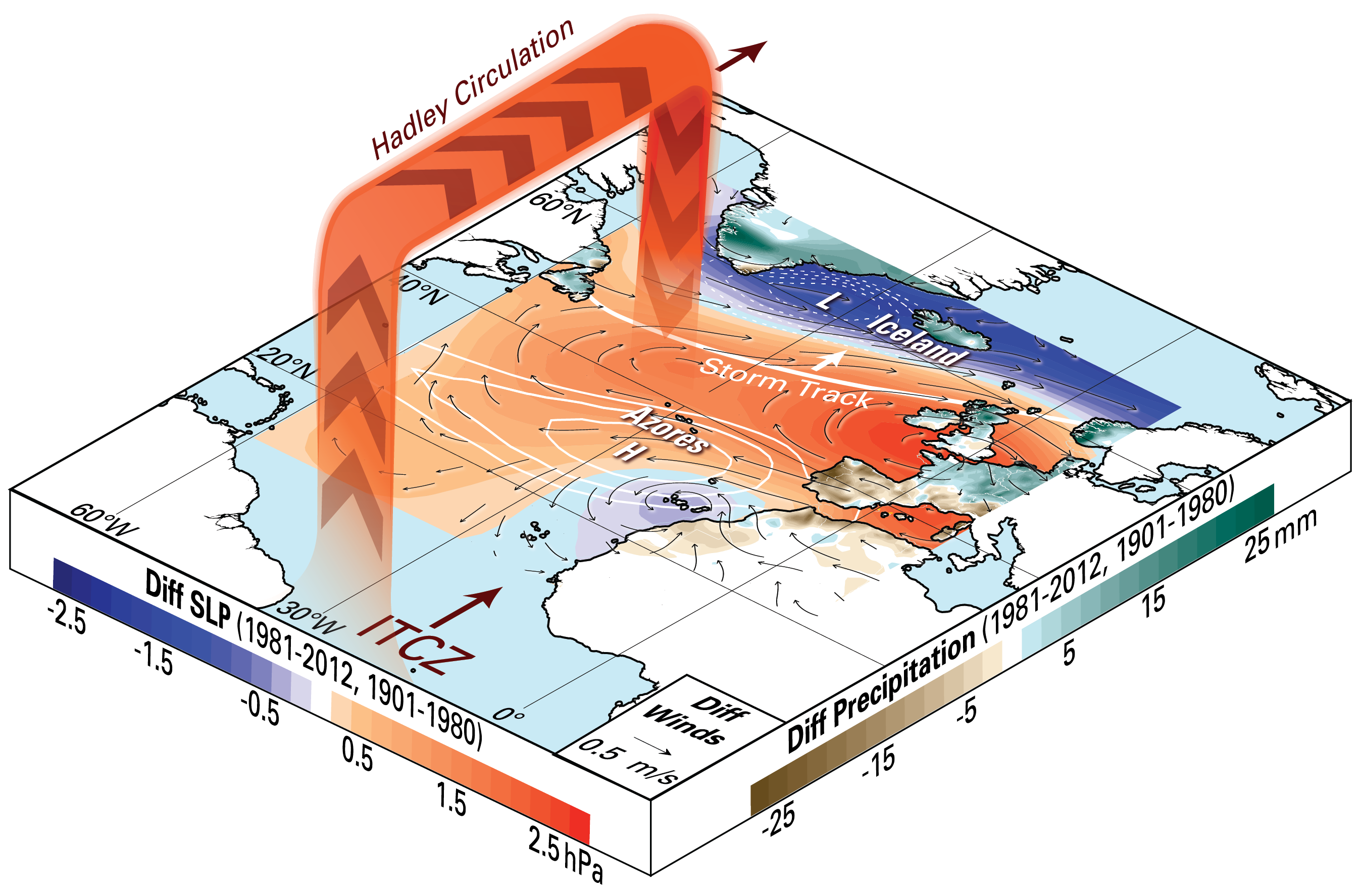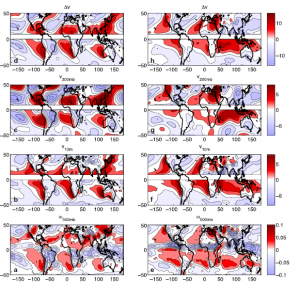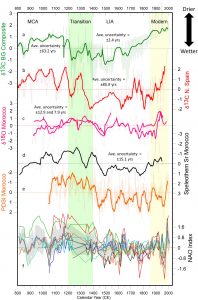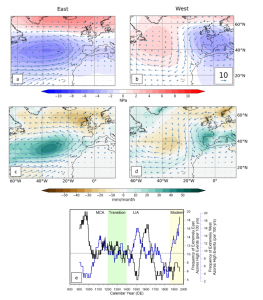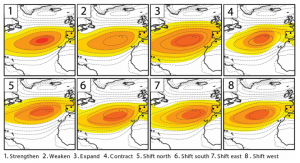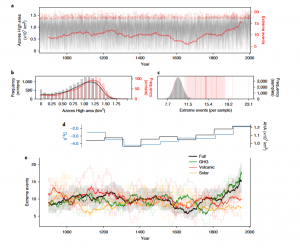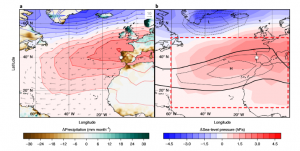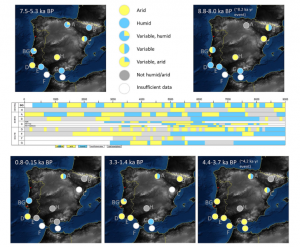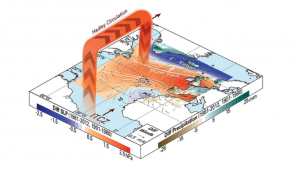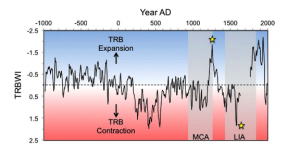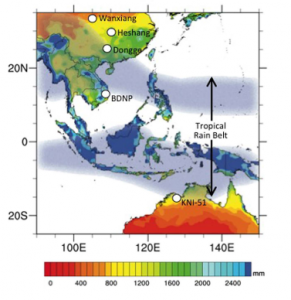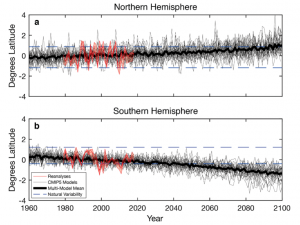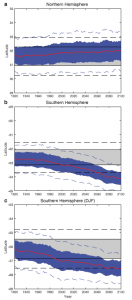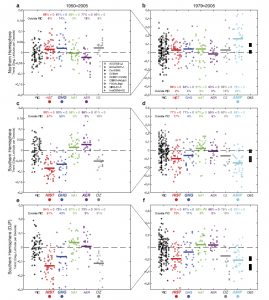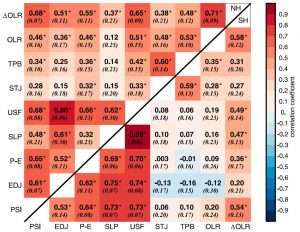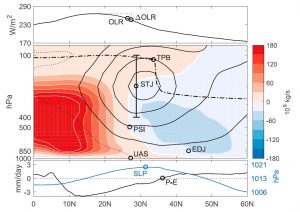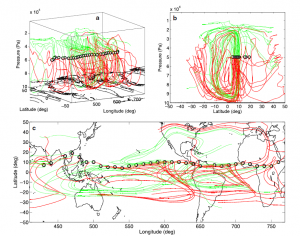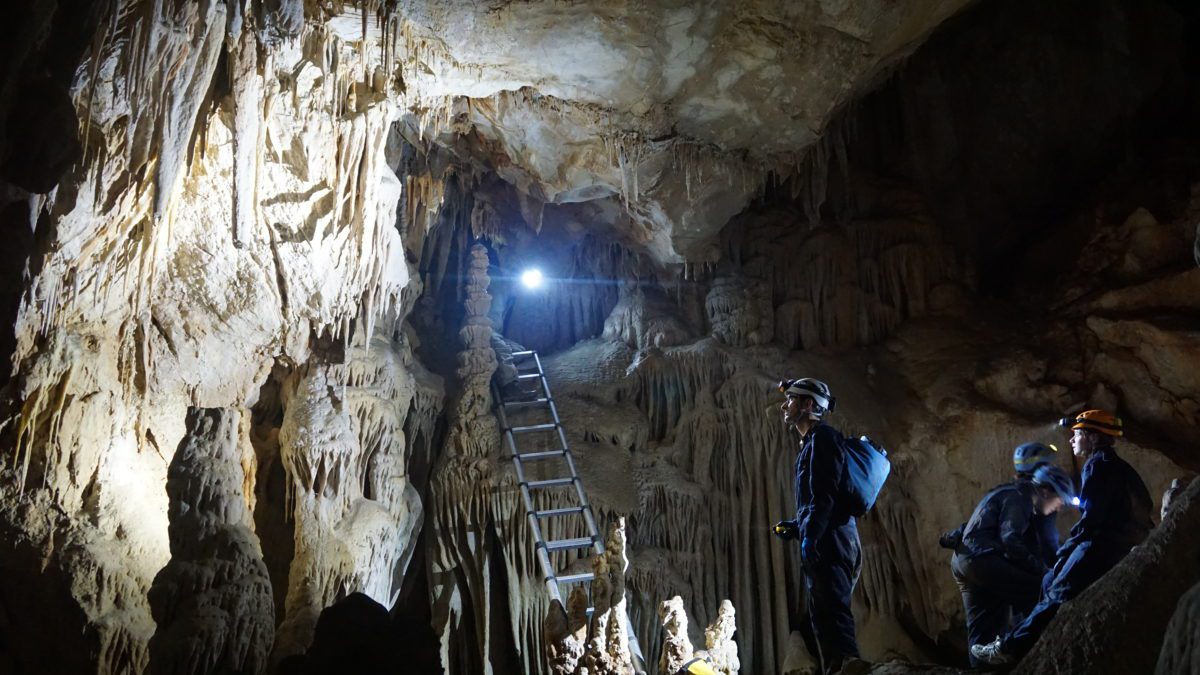The Hadley Circulation and Widening of the Tropics
The Hadley Circulation and Widening of the Tropics
Changes in subtropical precipitation and the Hadley circulation are inextricably linked. The original Halley-Hadley model cannot explain certain aspects of the Earth’s meridional circulation in the tropics and is of limited use in understanding regional changes in precipitation. In Karnauskas & Ummenhofer (2014), we expand on previous work on the regional and seasonal aspects of the Hadley circulation, in particular how land–sea temperature contrasts contribute to the strength and width of the Hadley circulation. We show that the Earth’s Hadley circulation is well described by three regionally distinct cells along the eastern edges of the major ocean basins with opposite circulations elsewhere. Moreover, comparable summertime hemisphere cells emerge in each region. While it has been recognized that continents modify the meridional pressure gradient, we demonstrate that a substantial part of the Earth’s Hadley circulation is driven by zonal pressure gradients that only exist due to continental heating and air-sea interaction. Projected changes in land–sea temperature contrasts in a warming climate due to the relatively low thermal capacity of land will also affect zonal pressure gradients and thus Hadley circulation strength and width, with implications for extremes in hydroclimate and freshwater resources across the increasingly vulnerable subtropics.
Widening of the Tropics
There is mounting evidence that the width of the tropics has increased over the last few decades, but there are large differences in reported expansion rates. This is, likely, in part due to the wide variety of metrics that have been used to define the tropical width. In Waugh et al. (2018), we perform a systematic investigation into the relationship among nine metrics of the zonal-mean tropical width using preindustrial control and abrupt quadrupling of CO2 simulations from a suite of coupled climate models. It is shown that the latitudes of the edge of the Hadley cell, the midlatitude eddy-driven jet, the edge of the subtropical dry zones, and the Southern Hemisphere subtropical high covary interannually and exhibit similar long-term responses to a quadrupling of CO2. However, metrics based on the outgoing longwave radiation, the position of the subtropical jet, the break in the tropopause, and the Northern Hemisphere subtropical high have very weak covariations with the above metrics and/or respond differently to increases in CO2 and thus are not good indicators of the expansion of the Hadley cell or subtropical dry zone. The differing variability and responses to increases in CO2 among metrics highlights that care is needed when choosing metrics for studies of the width of the tropics and that it is important to make sure the metric used is appropriate for the specific phenomena and impacts being examined.
Previous studies have documented a poleward shift in the subsiding branches of Earth’s Hadley circulation since 1979 but have disagreed on the causes of these observed changes and the ability of global climate models to capture them. This synthesis paper by Grise et al. (2019) reexamines a number of contradictory claims in the past literature and finds that the tropical expansion indicated by modern reanalyses is within the bounds of models’ historical simulations for the period 1979-2005. Earlier conclusions that models were underestimating the observed trends relied on defining the Hadley circulation using the mass streamfunction from older reanalyses. The recent observed tropical expansion has similar magnitudes in the annual mean in the Northern Hemisphere and Southern Hemisphere, but models suggest that the factors driving the expansion differ between the hemispheres. In the Southern Hemisphere, increasing greenhouse gases and stratospheric ozone depletion contributed to tropical expansion over the late twentieth century, and if greenhouse gases continue increasing, the Southern Hemisphere tropical edge is projected to shift further poleward over the twenty-first century, even as stratospheric ozone concentrations recover. In the Northern Hemisphere, the contribution of greenhouse gases to tropical expansion is much smaller and will remain difficult to detect in a background of large natural variability, even by the end of the twenty-first century. To explain similar recent tropical expansion rates in the two hemispheres, natural variability must be taken into account. Recent coupled atmosphere–ocean variability, including the Pacific decadal oscillation, has contributed to tropical expansion. However, in models forced with observed sea surface temperatures, tropical expansion rates still vary widely because of internal atmospheric variability.
As summarized by Staten et al. (2020), over the past 15 years, numerous studies have suggested that the sinking branches of Earth’s Hadley circulation and the associated subtropical dry zones have shifted poleward over the late twentieth century and early twenty-first century. Early estimates of this tropical widening from satellite observations and reanalyses varied from 0.25° to 3° latitude per decade, while estimates from global climate models show widening at the lower end of the observed range. In 2016, two working groups, the U.S. Climate Variability and Predictability (CLIVAR) working group on the Changing Width of the Tropical Belt and the International Space Science Institute (ISSI) Tropical Width Diagnostics Intercomparison Project, were formed to synthesize current understanding of the magnitude, causes, and impacts of the recent tropical widening evident in observations. These working groups concluded that the large rates of observed tropical widening noted by earlier studies resulted from their use of metrics that poorly capture changes in the Hadley circulation, or from the use of reanalyses that contained spurious trends. Accounting for these issues reduces the range of observed expansion rates to 0.25°–0.5° latitude decade-1—within the range from model simulations. Models indicate that most of the recent Northern Hemisphere tropical widening is consistent with natural variability, whereas increasing greenhouse gases and decreasing stratospheric ozone likely played an important role in Southern Hemisphere widening. Whatever the cause or rate of expansion, understanding the regional impacts of tropical widening requires additional work, as different forcings can produce different regional patterns of widening.
Long-term context - proxy-model synthesis
The seasonal north-south migration of the intertropical convergence zone defines the tropical rain belt, a region of enormous terrestrial and marine biodiversity and home to 40% of people on Earth. The tropical rain belt is dynamic and has been shown to shift south as a coherent system during periods of Northern Hemisphere cooling. However, recent studies of Indo-Pacific hydroclimate suggest that during the Little Ice Age (CE 1400–1850), the tropical rain belt in this region contracted rather than being displaced uniformly southward. This behavior is not well understood, particularly during climatic fluctuations less pronounced than those of the Little Ice Age, the largest centennial-scale cool period of the last millennium. In Denniston et al. (2016), we show that the Indo-Pacific tropical rain belt expanded and contracted numerous times over multi-decadal to centennial scales during the last 3,000 yr. By integrating precisely-dated stalagmite records of tropical hydroclimate from southern China with a newly enhanced stalagmite time series from northern Australia, our study reveals a previously unidentified coherence between the austral and boreal summer monsoon. State-of-the-art climate model simulations of the last millennium suggest these are linked to changes in the structure of the regional manifestation of the atmosphere’s meridional circulation.
Changes in subtropical High pressure systems
The Azores High is a persistent atmospheric high-pressure ridge over the North Atlantic surrounded by anticyclonic winds that steer rain-bearing weather systems and modulate the oceanic moisture transport to Europe. The areal extent of the Azores High thereby affects precipitation across western Europe, especially during winter. In Cresswell-Clay et al. (2022), we use observations and ensemble climate model simulations to show that winters with an extremely large Azores High are significantly more common in the industrial era (since CE 1850) than in pre-industrial times, resulting in anomalously dry conditions across the western Mediterranean, including the Iberian Peninsula. Simulations of the past millennium indicate that the industrial-era expansion of the Azores High is unprecedented throughout the past millennium (since CE 850), consistent with precipitation proxy evidence from Portugal. Azores High expansion emerges after CE 1850 and strengthens into the twentieth century, consistent with anthropogenically driven warming.
Iberia is predicted under future warming scenarios to be increasingly impacted by drought. While it is known that this region has experienced multiple intervals of enhanced aridity over the Holocene, additional hydroclimate-sensitive records from Iberia are necessary to place current and future drying into a broader perspective. Toward that end, Thatcher et al. (2020) present a multi-proxy composite record from six well-dated and overlapping speleothems from Buraca Gloriosa cave, located in western Portugal. The coherence between the six stalagmites in this composite stalagmite record illustrates that climate (not in-cave processes) impacts speleothem isotopic values. This record provides the first high-resolution, precisely dated, terrestrial record of Holocene hydroclimate from west-central Iberia. The Buraca Gloriosa record reveals that aridity in western Portugal increased secularly from 9.0 ka BP to present, as evidenced by rising values of both carbon (δ13C) and oxygen (δ18O) stable isotope values. This trend tracks the decrease in Northern Hemisphere summer insolation and parallels Iberian margin sea surface temperatures. The increased aridity over the Holocene is consistent with changes in Hadley Circulation and a southward migration of the Intertropical Convergence Zone. Centennial-scale shifts in hydroclimate are coincident with changes in total solar irradiance after 4 ka BP. Several major drying events are evident, the most prominent of which was centered around 4.2 ka BP, a feature also noted in other Iberian climate records and coinciding with well-documented regional cultural shifts. Substantially, wetter conditions occurred from 0.8 ka BP to 0.15 ka BP, including much of the ‘Little Ice Age’. This was followed by increasing aridity toward present day. This composite stalagmite proxy record complements oceanic records from coastal Iberia, lacustrine records from inland Iberia, and speleothem records from both northern and southern Spain and depicts the spatial and temporal variability in hydroclimate in Iberia. Furthermore, as detailed in Thatcher et al. (2022), multidecadal to centennial variability in the Buraca Gloriosa record and state-of-the-art last millennium climate model simulations show considerable coherence with precipitation-sensitive records from Spain and Morocco that, like Buraca Gloriosa, are strongly influenced by the intensity, size, and location of the Azores High. Model-proxy synthesis suggests that western Portugal was persistently dry during much of the Medieval Climate Anomaly consistent with other North Atlantic Oscillation reconstructions; however, even considering age uncertainties, the apparent timing in the transition from a relatively dry Medieval Climate Anomaly to a wetter Little Ice Age is spatially variable and confirms the non-stationary behavior of the Azores High system indicated by model output.
Further information
Cresswell-Clay, Ummenhofer CC, Thatcher DL, Wanamaker AD, Denniston RF, Asmerom Y, and Polyak VJ. (2022). Twenthieth Century Azores High expansion unprecedented in the last 1200 years. Nature Geoscience, doi:10.1038/s41561-022-00971-w. Reprint
Denniston RF, Ummenhofer CC, Wanamaker AD, Villarini G, Lachniet MS, Asmerom Y, Polyak VJ, Cugley J, Woods D, Passaro KJ, Campbell N, and Humphreys WF. (2016). Expansion and contraction of the Indo-Pacific tropical rain belt over the last three millennia. Scientific Reports, 6, doi:10.1038/srep34485. Reprint
Grise KM, Davis SM, Simpson IR, Waugh DW, Fu Q, Allen RJ, Rosenlof KH, Ummenhofer CC, Karnauskas KB, Maycock AC, Quan X-W, Birner T, and Staten PW (2019). Recent tropical expansion: Natural variability or forced response? Journal of Climate, 32, 1551-1571. Reprint
Staten PW, Grise KM, Davis SM, Karnauskas KB, Waugh DW, Maycock A, Fu Q, Cook K, Adam O, Simpson IR, Allen RJ, Rosenlof K, Chen G, Ummenhofer CC, Quan X-W, Kossin JP, Davis NA, and Son, S-W. (2020). Tropical widening: From global variations to regional impacts. Bulletin of the American Meteorological Society, doi:10.1175/BAMS-D-19-0047.1. Reprint
Thatcher DL, Wanamaker AD, Denniston RF, Asmerom Y, Polyak V, Ummenhofer CC, Gillikin DP, and Haws J. (2020). Hydroclimate variability from Western Iberia (Portugal) during the Holocene – insights from a composite stalagmite isotope record. The Holocene, 30, 966-986. Reprint
Thatcher DL, Wanamaker AD, Denniston RF, Ummenhofer CC, Asmerom Y, Polyak VJ, Cresswell-Clay N, Hasiuk F, Haws J, and Gillikin D. (2022). Iberian hydroclimate variability and the Azores High during the last 1200 years: Evidence from proxy records and climate model simulations. Climate Dynamics, doi:10.1007/s00382-022-06427-6. Reprint
Waugh DW, Grise KM, Seviour WJM, Davis SM, Davis N, Adam O, Son S-W, Simpson IR, Staten PW, Maycock AC, Ummenhofer CC, Birner T, and Ming A. (2018). Revisiting the relationship among metrics of tropical expansion. Journal of Climate, 31, 7565-7581. Reprint

